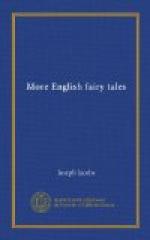LIII. THE HEDLEY KOW
Source.—Told to Mrs. Balfour by Mrs. M. of S. Northumberland. Mrs. M.’s mother told the tale as having happened to a person she had known when young: she had herself seen the Hedley Kow twice, once as a donkey and once as a wisp of straw. “Kow” must not be confounded with the more prosaic animal with a “C.”
Parallels.—There is a short reference to the Hedley Kow in Henderson, l.c., first edition, pp. 234-5. Our story is shortly referred to thus: “He would present himself to some old dame gathering sticks, in the form of a truss of straw, which she would be sure to take up and carry away. Then it would become so heavy that she would have to lay her burden down, on which the straw would become ‘quick,’ rise upright and shuffle away before her, till at last it vanished from her sight with a laugh and shout.” Some of Robin Goodfellow’s pranks are similar to those of the Hedley Kow. The old woman’s content with the changes is similar to that of “Mr. Vinegar.” An ascending scale of changes has been studied by Prof. Crane, Italian Popular Tales, p. 373.
LIV. GOBBORN SEER
Source.—Collected by Mrs. Gomme from an old woman at Deptford. It is to be remarked that “Gobborn Seer” is Irish (Goban Saor = free carpenter), and is the Irish equivalent of Wayland Smith, and occurs in several place names in Ireland.
Parallels.—The essence of the tale occurs in Kennedy, l.c., p. 67, seq. Gobborn Seer’s daughter was clearly the clever lass who is found in all parts of the Indo-European world. An instance in my Indian Fairy Tales, “Why the Fish Laughed” (No. xxiv.). She has been made a special study by Prof. Child, English and Scotch Ballads, i., 485, while an elaborate monograph by Prof. Benfey under the title “Die Kluge Dirne” (reprinted in his Kleine Schriften, ii., 156, seq.), formed the occasion for his first presentation of his now well-known hypothesis of the derivation of all folk-tales from India.
Remarks.—But for the accident of the title being preserved there would have been nothing to show that this tale had been imported into England from Ireland, whither it had probably been carried all the way from India.




